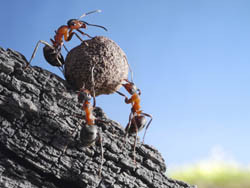Genes affecting social behaviour in ants
Eusociality is the complex organisation of animal sociality, defined by cooperative care for offspring and division of labour into reproductive and non-reproductive castes. In contrast to human sociality depending on cultural elements, eusocial insects, such as ants, bees, wasps and termites, evolved by natural selection. Evolutionary theories emphasise the power of cooperation to achieve higher levels of organisation, and the corrupting tendencies from lower levels of selection that maintain selfish traits. The EU-funded project 'Genome evolution in attine ants' (GENTS) used a well-studied social insect model, the fungus-growing ants. Project scientists studied the epigenetic mechanisms that maintain and regulate genome-level mechanisms that allow conditional gene expression and the expression of selfish traits by individuals within societies. A cutting-edge research programme in evolutionary biology (Centre for Social Evolution, University of Copenhagen) was combined with Chinese genome sequencing excellence (BGI Shenzhen) for this effort. GENTS focused on the epigenetic regulation of caste differentiation and RNA editing in Acromyrmex echinatior (leaf-cutting ant). As epigenetic mechanisms regulate gene function, the project aimed to clarify its role in brain gene expression regulation across the three female castes of A. echinatior. The scientists found that RNA editing was pervasive across many genes expressed in the brains of small workers, large workers and gynes (virgin queens). Over 10 000 RNA-editing evens existed in over 800 genes. These RNA-editing genes were functionally enriched for neurotransmission, circadian rhythm, temperature response, RNA splicing and carboxylic acid biosynthesis. An important GENTS finding was the varied editing levels of the same sites between castes. This suggests that RNA editing may be a general mechanism that shapes caste behaviour in ants, after the genetic code has been transcribed. GENTS explored for the first time and significantly advanced our understanding of RNA-editing regulation in eusocial insect species.







